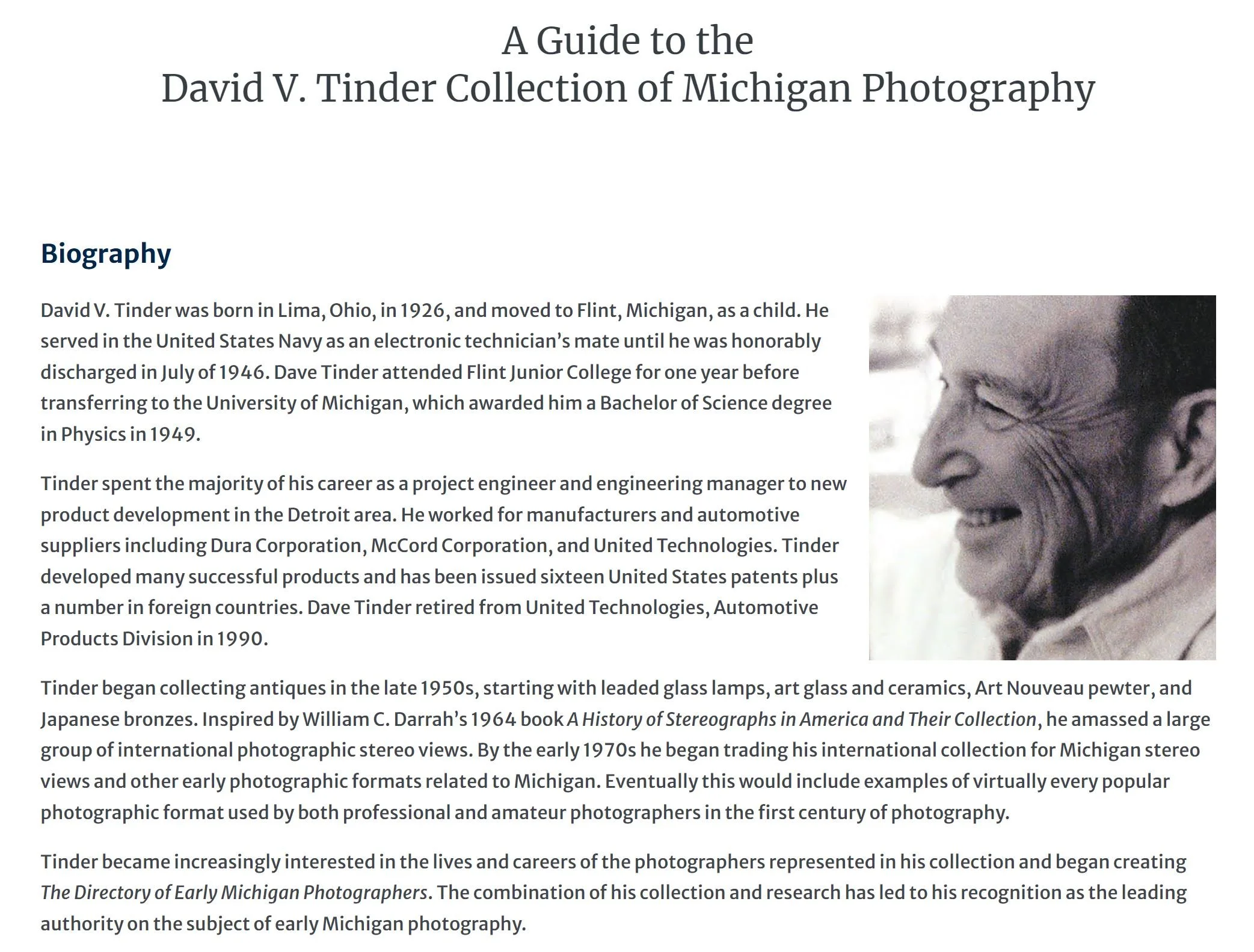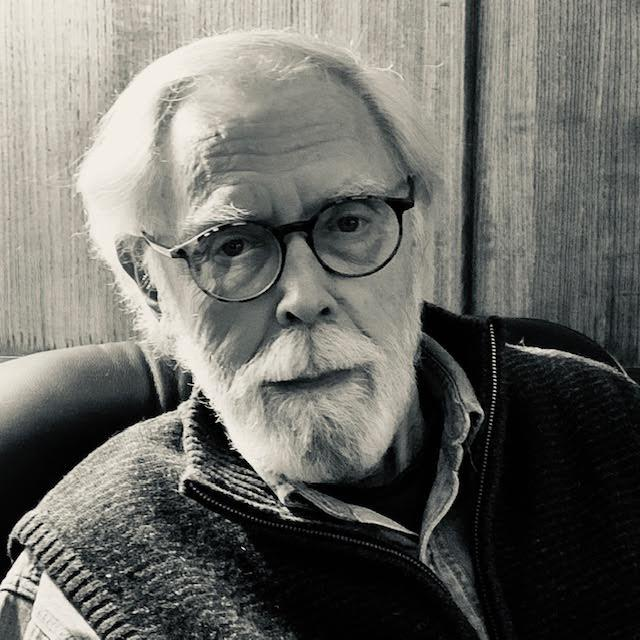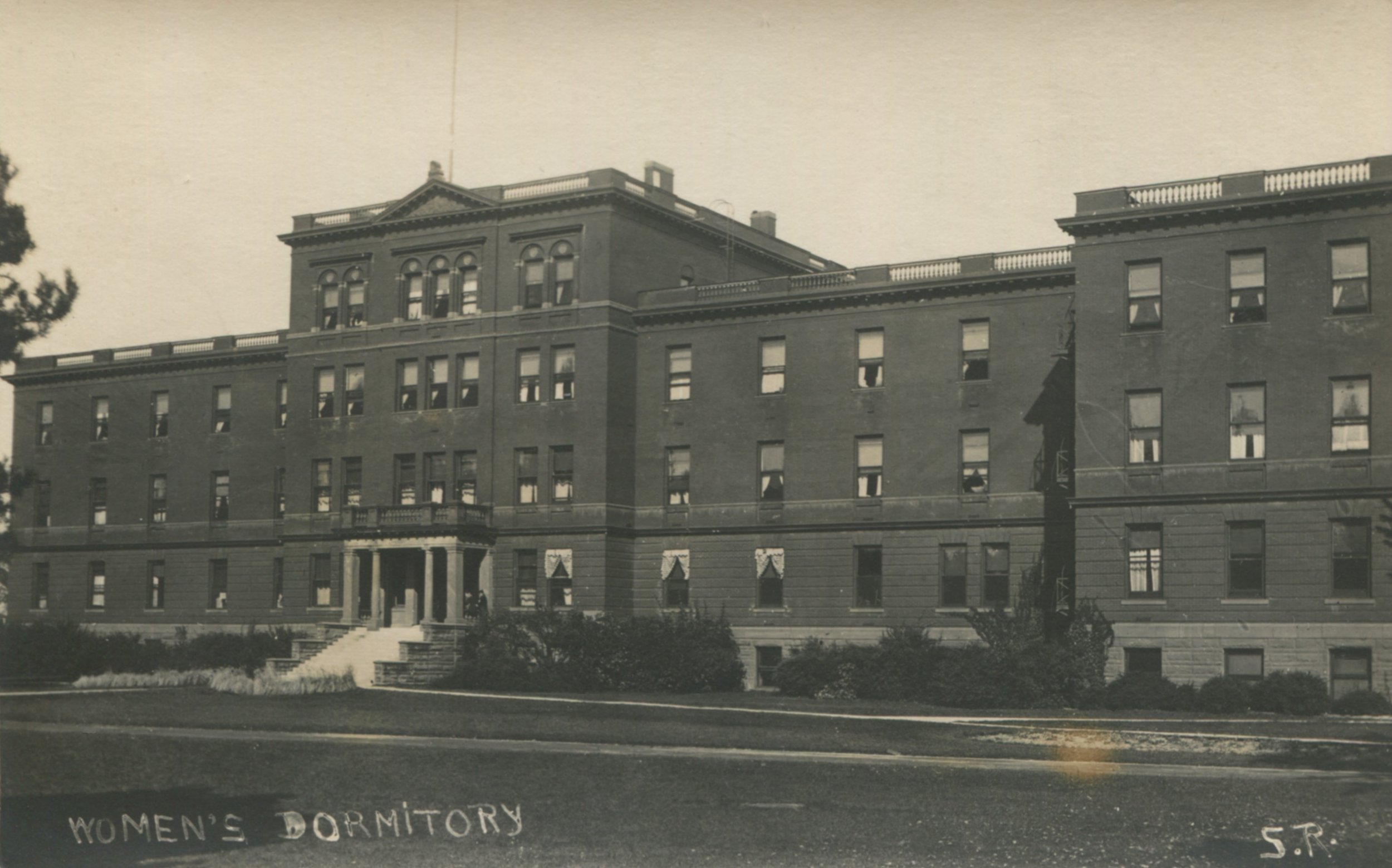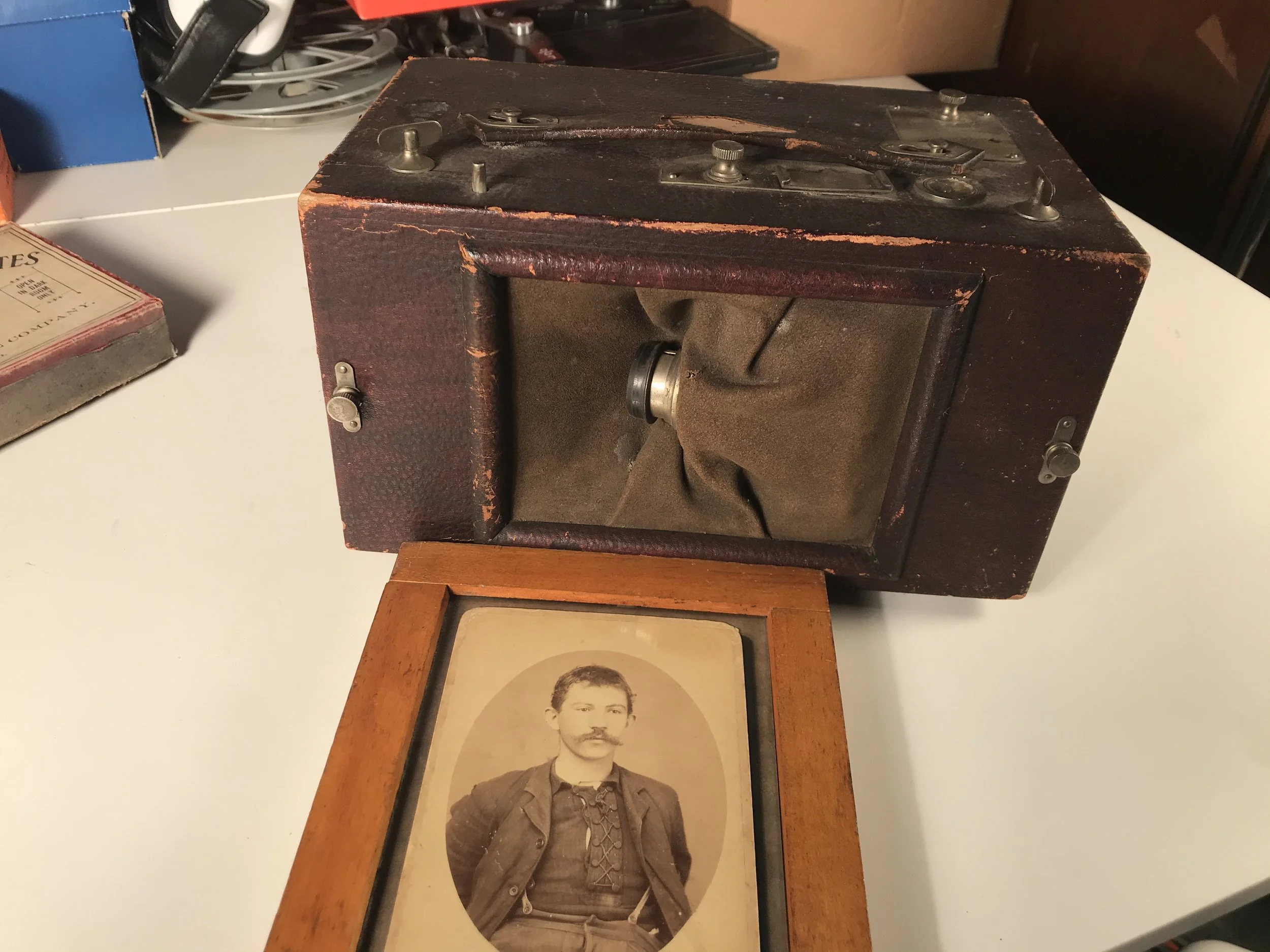Lecture Series

History of Real Photo Postcards
Rescheduled from March 4th to May 13th due to weather.
In conjunction with the “By the Yard” panoramic photo exhibit sponsored by the Library of Michigan and the Historical Society of Greater Lansing, a lecture series is being presented this winter and spring. Next, we are hosting a lecture by noted photographer and vintage postcard collector and dealer Doug Aikenhead of Ann Arbor at 1:00 p.m., Saturday, May 13 in the Lake Erie Room at the Library of Michigan, 702 West Kalamazoo St., Lansing. The lecture and exhibit are free and open to the public. Parking is free in the Library parking lot. As a backdrop to the lecture, the exhibit of yard long panoramic photographs from across Michigan will continue to be on display.
Aikenhead will showcase some of his rare “Real Photo Postcards” and discuss the unique phenomena of citizen photography portrayed in these specialized postcards which are actual photographs taken by both amateur and professional photographers. What makes real photo postcards unique are they are photographs that are printed directly on photo paper. This distinguishes this unique postcard from mass produced postcards.
Real photo postcards boomed when Eastman Kodak began marketing postcard sized photographic paper in 1903. In 1903, Kodak also introduced the 3A-Kodak Autographic Camera- which allowed the photographer to use a metal stylus to write descriptions and locations directly on the negative which then appear as white on a final print.
The final print was actually a one-to-one contact print (3 ¼ by 5 ½ inch) with the photo on one side and the mailing information and area for a message preprinted on the reverse side.
Today, these photographs tell the early history of the United States and how these uncommon photographs contributed to the mythos of the country. Typical real photo postcards were taken of small town street scenes, parades and patriotic events and family gatherings.
On the reverse side of the real photo postcard senders would often indicate that they were there and took the photograph. Local photographic shops also would produce quantities of cards for the photographer.
Aikenhead said, “These photographs tell us a lot about who we are and what was important to people more than 100 years ago.”
“These real photo postcards provide a jumping off point for collectors and historians who research more details about who or what is shown in the photograph,” he said.
Aikenhead not only collects but also has been selling real photo postcards since 1977.
A large percentage of real photo postcards were never sent and mint postcards of special circumstances like early flight are rare and expensive to collect. Postcards of early street scenes especially of small towns are also highly collectible.
Real photo postcards were used to record tragedies such as fires, train wrecks and floods and often are the only photographic record of the event. Professional photographers were often on the scene first and within a day could offer the real photo record for sale.
A classic example of that experience is the real photo postcards taken of the Bath School Disaster were sold as a set at local stores within two days of the tragedy; and real photo postcards could be purchased for six for 50 cents. Professional photographers also were quick to take photos of sports teams and school classes.
Today, real photo postcards are often used as illustrations in books mostly because they are accessible and copyright free.
Aikenhead will provide a framework for collectors about how to identify a real photo postcard and how to rule out cards that look similar, but were mass produced. He also will show how to identify counterfeit reprints.
Attendees are encouraged to bring their own real photo postcards for a post lecture show and tell.
About the presenter:
Doug Aikenhead is a photographer and vintage postcard collector and dealer. He began collecting postcards during a year-long photographic road trip in 1977. Doug has been a postcard dealer since 1993 and enjoys discussing postcards with fellow collectors and dealers at a dozen postcard shows every year. He also writes occasional articles about vintage postcards. Doug earned his Master of Fine Arts degree at Cranbrook Academy of Art, taught photography at Detroit’s College for Creative Studies and other institutions, and co-edited Detroit Images: Photographs of the Renaissance (Wayne State University Press, 1989). He is the current president of the Michigan Photographic Historical Society.

"In The Day": Photos by Fred Richardson
The Historical Society of Greater Lansing is excited to welcome Adolph Burton, lifelong Lansing resident and community historian, to discuss the history of Black Lansing photographer Fred Richardson, who documented everyday life in the segregated society of mid-twentieth century Lansing.

Photography of Michigan's Upper Peninsula
Photographer Takes You on a Historic Photographic Tour of the Upper Peninsula
The Historical Society of Greater Lansing is hosting Jack Deo, a photographic historian from Marquette, Michigan for a lecture on the historic photographers of the Upper Peninsula including the outlaw “Black Bart,” who killed a man while robbing a stagecoach, 1:00 p.m., Saturday, April 15 at the Library of Michigan, Lake Erie Room, 702 W. Kalamazoo St., Lansing.
During his long career in Marquette, Deo has collected nearly 1 million images taken in the Upper Peninsula dating back to the early timber and mining industry days. The photographs represent every important industrial, cultural and social location and event in the Upper Peninsula ranging from mining and lumbering to dancing bears and Native Americans.
He recently received the Upper Peninsula Folklife Award presented by the Beaumer U.P. Heritage Center at Northern Michigan University. He also served as a curator for a current exhibit, “Exposing Photography: Anything but a Small Business,” at the Marquette Historical Society.
Since moving to Marquette in the early 1970s to attend Northern Michigan University, Deo has collected and curated some of the most important photographic collections emanating from the Upper Peninsula including the works of B.F. Child; famed National Geographic wildlife photographer George Shiras; Harold DuCharme; Tappan Gregory; William Harris and Edgar and Merta Lemon.
He will also show photographs from John M. Longyear, a wealthy industrialist, Congressman and amateur photographer, who was a lawyer, originally from Lansing, Michigan.
Deo said many of the photographs he will focus on were often sold as souvenirs or as stereographs and some were important enough to appear in Harpers Weekly.
Deo will also discuss and show the photographic work of the famous and infamous U.P. photographer “Black Bart” who learned his photographic trade while serving time at Marquette Prison after killing a man in Gogebic County during the last stage coach robbery east of the Mississippi in 1889.
“Black Bart” whose real name was Reimund Holzhey would use his photographic skills to photograph tourists in the elegant gardens surrounding the prison and while in prison would learn the fine art of hand coloring photographs.
Deo recently acquired the panoramic camera used by “Black Bart” to photograph scenes across the U.P after his release. Deo also will bring the first trail cam in the world perfected by George Shiras who took the first outdoor flash photograph of a deer in nature.
Deo said he was inspired to enter the field of photography by the tin typist at Greenfield Village who was also his next-door neighbor in Dearborn
“Greenfield Village was an important influence in my life,” he said.

The David V. Tinder Collection of Michigan Photography
The Historical Society of Greater Lansing is hosting an educational program on “Tinder,” 7 p.m., Thursday, March 16 at the Library of Michigan, Lake Erie Room, 702 West Kalamazoo St. The event is free and parking is adjacent to the Library.
To be clear the program is not about the on-line dating site, but it is about the David V. Tinder Collection of Michigan Photography of more than 100,000 photographs held at the Clements Library at The University of Michigan. Clayton Lewis, curator of the collection, will present a program on Tinder - the photo collection - not the dating site and show how it can be used to identify more details about a coveted family photograph and the photographer who took it.
Tinder was born in Lima, Ohio, in 1926, and moved to Flint, Michigan, as a child. He graduated from the University of Michigan, in 1949 with a degree in Physics. He spent most of his career as a project engineer and engineering manager working for Dura Corporation, McCord Corporation, and United Technologies. He held 16 United States patents plus a number in foreign countries.
Tinder began collecting antiques in the late 1950s, starting with leaded glass lamps, art glass and ceramics, Art Nouveau pewter, and Japanese bronzes. Inspired by William C. Darrah’s 1964 book A History of Stereographs in America and Their Collection, he amassed a large group of international photographic stereo views. By the early 1970s he began trading his international collection for Michigan stereo views and other early photographic formats related to Michigan. Eventually this would include examples of virtually every popular photographic format used by both professional and amateur photographers in the first century of photography.
Tinder became interested in the lives and careers of the photographers represented in his collection and began creating The Directory of Early Michigan Photographers. The combination of his collection and research has led to his recognition as the leading authority on the subject of early Michigan photography.
The Tinder Collection consists of more than 100,000 images in a variety of formats including daguerreotypes, ambrotypes, tintypes, cartes de visite, cabinet photographs, real photo postcards, stereographs, and mounted and unmounted paper prints.
The collection is primarily made up of vernacular photographs of everyday life in Michigan taken by both professional and amateur photographers from the 1840s into the mid-twentieth century. In addition to supporting local history research, the collection has resources for the study of specific events and subjects. Included are images related to lumbering; mining; suburbanization; the industrialization of cities; travel and transportation; the impact of the automobile; the rise of middle-class leisure society; fashion and dress; ethnicity and race; the role of fraternal organizations in society; and the participation of photographers in business, domestic, and social life. The collection is only partially open for research.
This reference work contains biographical information about virtually every known commercial and significant amateur photographer in the state of Michigan from the first known appearances in the 1840s into the early twentieth century.
Because the collection is so large much of it is still being catalogued; however the list of photographers, their hometown, their years of operation and detailed biographies are available on line at https://clements.umich.edu/files/tinder_directory.pdf
Lewis will walk people through how they can use the on-line catalog to help identify the history of family photographs and narrow down where and when they were taken.
The online resource is the most valuable research resource on Michigan Photographers ever compiled.
Read more about the collection here: David V. Tinder Collection of Michigan Photography - UM Clements Library (umich.edu).
The Tinder program is part of a lecture series on Michigan Photography being hosted by the Historical Society and the Library of Michigan in conjunction with the current exhibition on Michigan panoramic photography featuring 53 dramatic photographs from across the state.

A Capitol & Its Cameras
We are pleased to continue extending the invitation from our friends at the Michigan State Capitol to attend their monthly Rise and Progress program series. The February 2023 program is entitled A Capitol & Its Cameras. The program will be held in person on Tuesday, February 21, 2023, at 7:00 p.m. in the Lake Erie Room at the Library of Michigan. No RSVP needed for the in person program. A virtual version will be offered on Thursday, February 16, 2023, at 3:00 p.m. The virtual program requires an RSVP, please send you RSVP to capitoltourguides@legislature.mi.gov. The program will be presented by Capitol Photo Archivist Jacob McCormick.
Description from the Michigan State Capitol:
The Michigan Capitol has been photographed since its inception, from construction through the 144 years since Dedication Day. Join us for an illustrated walk through the history of photographic formats, from early plate photos into the 20th century’s modern gelatin prints, including rare views of early Lansing. Enjoy a look at our photo collection, including views of the restoration, events like rallies and inaugurations, press photographs, visitors’ snapshots, panoramas, portraits, and more! Plus, learn how your photos can become a piece of the Capitol’s photographic record.

By The Yard: Michigan in Panoramic Photography
The Historical Society is proud to present “By The Yard: Michigan in Panoramic Photography,” the exhibit and lecture. Join us on Saturday, February 11, 2023, at 1:00 p.m. in the Lake Erie Room at the Library of Michigan, 702 W. Kalamazoo St. for the opening of the new exhibit on panoramic photography of our great state! The exhibit is more than 3 years in the making and came from the mind of the late collector, community historian, and friend of the HSGL, Dan Barber. The opening event will include a lecture and tour of the exhibit.
The “By The Yard” lecture will begin at 1:00 p.m. and will be presented by exhibit co-curator Jacob McCormick, a trustee of the Historical Society of Greater Lansing. McCormick is a historian and collector of 19th century Lansing photography. He holds a Master of Library and Information Science and is the photo archivist for the Michigan State Capitol.
“By the Yard” - the lecture - will cover the history of panoramas from the earliest days of photography to modern cell phone panoramas. The presentation will be illustrated with panoramic photos from the exhibition and those that didn’t make the cut due to the vast number that surfaced in preparation for the exhibit. The lecture will be followed by a tour of the exhibit.
“By the Yard” - the exhibit - features more than 50 panoramic photographs from across the state of Michigan. They include groups of people and landscapes, Camp Custer to Marquette, and the University of Michigan to Michigan State University. There is truly something for everyone to enjoy!
The exhibit is sponsored by the Historical Society of Greater Lansing and the Library of Michigan. It was co-curated by Bill Castanier, Karla Barber, and Jacob McCormick.
















